Traditional Moroccan Recipes You’ll Love
Did you know that the aromatic ras el hanout spice blend used in many North African dishes can contain up to 30 different spices? This intricate blend is just one of the many elements that make Moroccan cooking so rich and complex.
We will take you on a culinary journey through the vibrant souks and family kitchens of Morocco, exploring the traditional recipes that have been passed down through generations. With staple ingredients like lamb, couscous, and preserved lemons, you’ll learn how to create authentic dishes that balance sweet and savoury flavours.
From hearty tagines to sweet pastries, our guide will introduce you to the essential spices and cooking techniques that give Moroccan cuisine its distinctive character. Whether you’re a novice cook or an experienced chef, these traditional recipes will transport you to the heart of Morocco.
The Rich Heritage of Moroccan Cuisine
Moroccan cuisine is a rich tapestry woven from centuries of cultural exchange. This diverse heritage is reflected in its vibrant food culture, which has been shaped by Arab, Berber, Mediterranean, and European traditions. We will explore how this blend of influences has resulted in a unique culinary identity.
Key Ingredients in Traditional Moroccan Cooking
Moroccan cooking relies heavily on a few staple ingredients. These include preserved lemons, which add a salty, tangy flavour, and olives, which provide a rich, savory taste. High-quality olive oil is also fundamental, used liberally in cooking and dressings. Additionally, lamb is a popular protein, often used in traditional dishes.
Essential Spices and Flavourings
The distinctive flavour profile of Moroccan cuisine is largely due to its spices. Ras el hanout, a complex blend of spices, is a cornerstone of many recipes. Other essential spices include cumin, saffron, ginger, paprika, cardamom, cinnamon, and turmeric. These spices are often combined in various ways to create the rich, aromatic flavours characteristic of Moroccan food.
- We’ll delve into the fascinating history of Moroccan cuisine, shaped by centuries of cultural exchanges.
- You’ll learn how geography has influenced Moroccan cooking, with variations between coastal and inland regions.
- We’ll explore key ingredients like preserved lemons, olives, and olive oil that form the foundation of Moroccan cooking.
- The spice palette of Moroccan cuisine is distinctive, featuring combinations of cumin, coriander, cinnamon, saffron, and paprika.
- We’ll explain how Moroccan cooks balance sweet and savoury elements through dried fruits, honey, and aromatic spices.
Moroccan Cuisine Recipes: Essential Kitchen Tools
Exploring Moroccan cuisine requires more than just recipes; it demands the right cooking vessels and tools. To cook authentic Moroccan dishes, you’ll need a few essential kitchen tools that have been used for centuries in Moroccan kitchens.
The Tagine Pot
The iconic tagine pot is a conical clay cooking vessel that gives many Moroccan dishes their name and distinctive flavour profile. Its unique design creates a self-basting cooking environment, producing tender and flavourful dishes with minimal liquid. When you cook with a tagine, the heat is distributed evenly, allowing the flavours to meld together beautifully.
Other Traditional Cookware
While a tagine is a valuable tool, it’s not the only cookware needed for Moroccan cooking. Other essential tools include a couscoussier, a two-part steamer specifically designed for preparing couscous, and traditional clay cooking pots. If you don’t have a tagine, you can achieve similar results using a heavy-bottomed Dutch oven or an enamelled cast-iron casserole, which can withstand high heat and distribute it evenly.
Classic Moroccan Tagine Recipes
In Moroccan cuisine, tagines are more than just a meal; they’re an experience, and we’ll guide you through some of the most beloved recipes. Tagine dishes are known for their rich flavours and tender meat, achieved through slow cooking in a traditional clay pot.
Chicken Tagine with Preserved Lemons and Olives
This quintessential Moroccan chicken tagine recipe combines juicy chicken thighs marinated in authentic Moroccan spices with preserved lemons and olives, creating a rich and flavourful sauce. The dish is perfect for serving over couscous, which soaks up the aromatic broth beautifully.
Lamb Tagine with Apricots
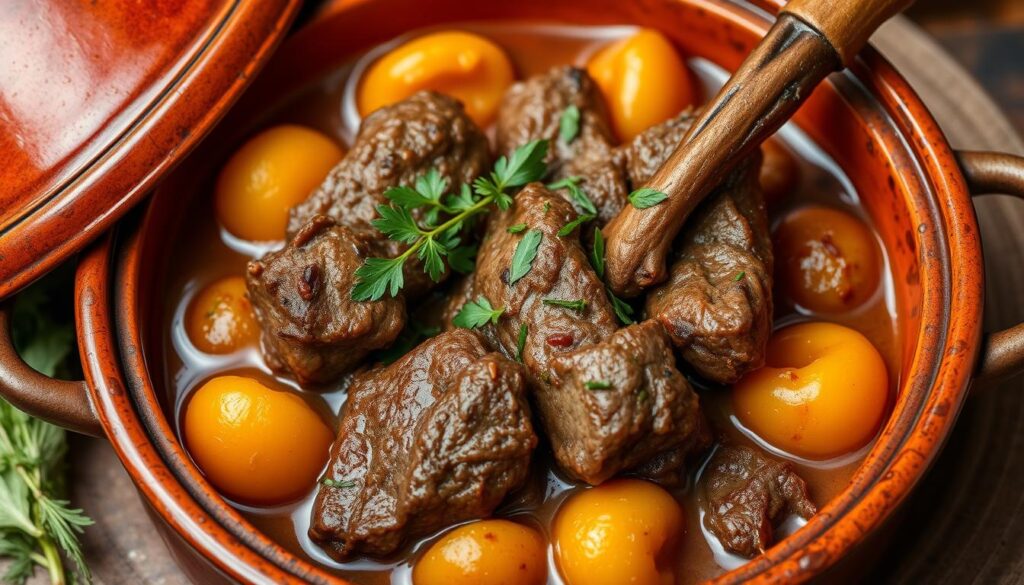
Lamb tagine with apricots is another classic Moroccan recipe that showcases the talent for combining meat with sweet fruits. The slow-cooked lamb becomes tender and succulent, infused with the flavours of ginger, cumin, and coriander, while the apricots add a sweet and tangy contrast.
Both of these tagine recipes highlight the versatility and richness of Moroccan cuisine, offering a culinary journey through the blend of aromatic spices, tender meats, and sweet or tangy accompaniments. Whether you’re cooking chicken or lamb, the key to a great tagine lies in the slow cooking process, which allows the flavours to meld together beautifully.
Vegetarian Tagine Options
Discover the rich flavours and aromas of Moroccan vegetarian tagines, perfect for any occasion. We will introduce you to hearty vegetarian tagine recipes that showcase the versatility of Moroccan cuisine beyond meat-based dishes.
We’ll share tips for building layers of flavour in vegetarian dishes using traditional Moroccan techniques and spice combinations. You’ll learn how to create a flavourful Moroccan vegetable tagine loaded with warm spices and seasonal vegetables, perfect for colder months.
Moroccan Vegetable Tagine
This Moroccan Vegetable Tagine is a perfect stew for the colder months, loaded with warm spices and hearty veggies. It’s a flavorful vegan meal that’s sure to warm up the family when served over couscous or with warm bread.
Chickpea and Butternut Squash Tagine
Our chickpea and butternut squash tagine is a protein-rich dish that balances earthy legumes with sweet, tender squash. This recipe is versatile, allowing you to serve vegetarians and carnivores simultaneously by cooking the sausage separately.
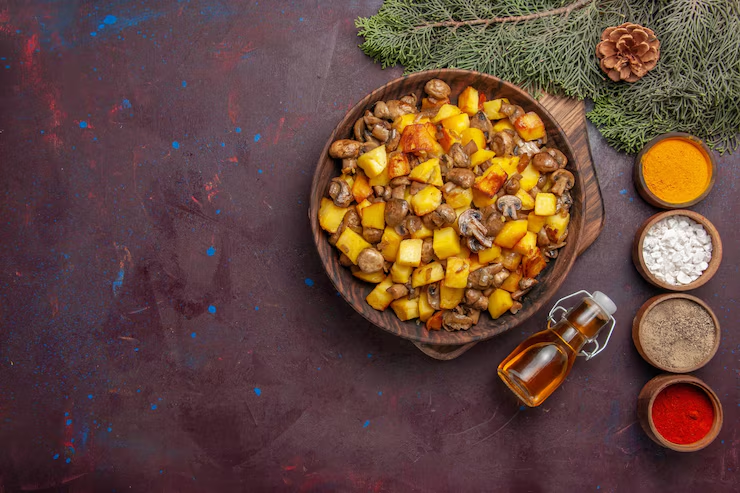
These vegetarian tagine options can be served in various ways, including pairing them with couscous, crusty bread, or as part of a larger Moroccan feast. Enjoy exploring these delicious and authentic Moroccan recipes!
Authentic Moroccan Couscous Dishes
In Morocco, couscous is more than just a meal; it’s a cultural experience that brings families together. We love sharing this traditional dish with our friends and family, and we’re excited to guide you through the process.
Traditional Friday Couscous with Lamb
Every Friday, our families in Morocco gather around the table for a delicious couscous meal featuring tender lamb, stewed vegetables, and a rich, flavourful broth. To make this authentic Moroccan couscous recipe, you’ll need to start with perfectly cooked couscous, which can be achieved using a couscoussier or alternative steaming techniques.
The lamb is slow-cooked to perfection, absorbing the aromatic spices and blending with the stewed vegetables to create a hearty and satisfying dish. This traditional Friday couscous is not just a meal; it’s a time for families to come together, share stories, and enjoy each other’s company.
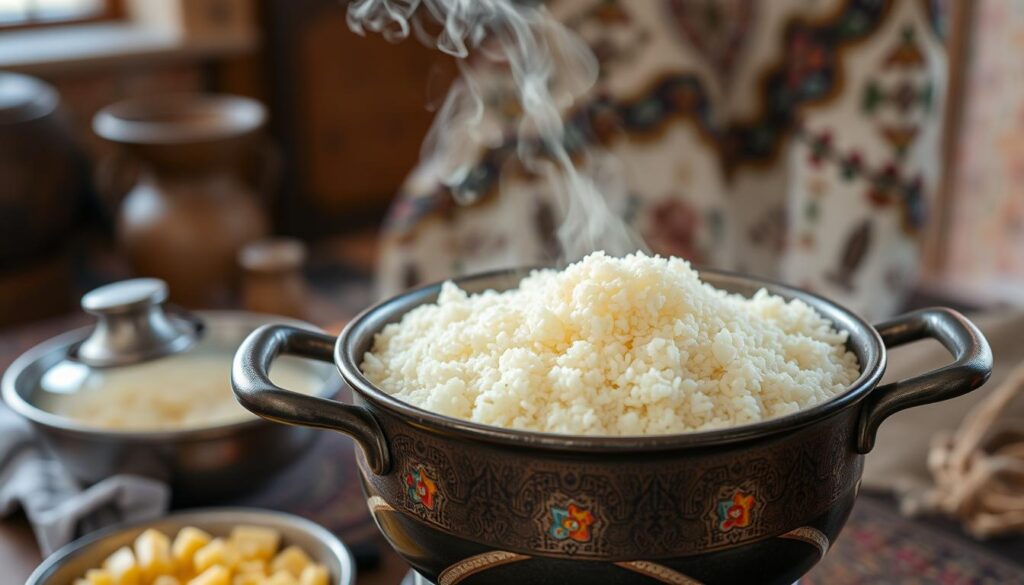
Quick Couscous Salad with Vegetables
For a lighter and fresher take on couscous, our quick couscous salad recipe is a perfect option. This salad combines cooked couscous with a variety of fresh vegetables, such as cherry tomatoes, cucumbers, and bell peppers, all tossed in a tangy and refreshing dressing.
This couscous salad is not only delicious but also incredibly easy to make, requiring just a few minutes to prepare. It’s an ideal side dish or light meal that’s perfect for any occasion, and it’s a great way to enjoy the flavours of Morocco in a simple and healthy way.
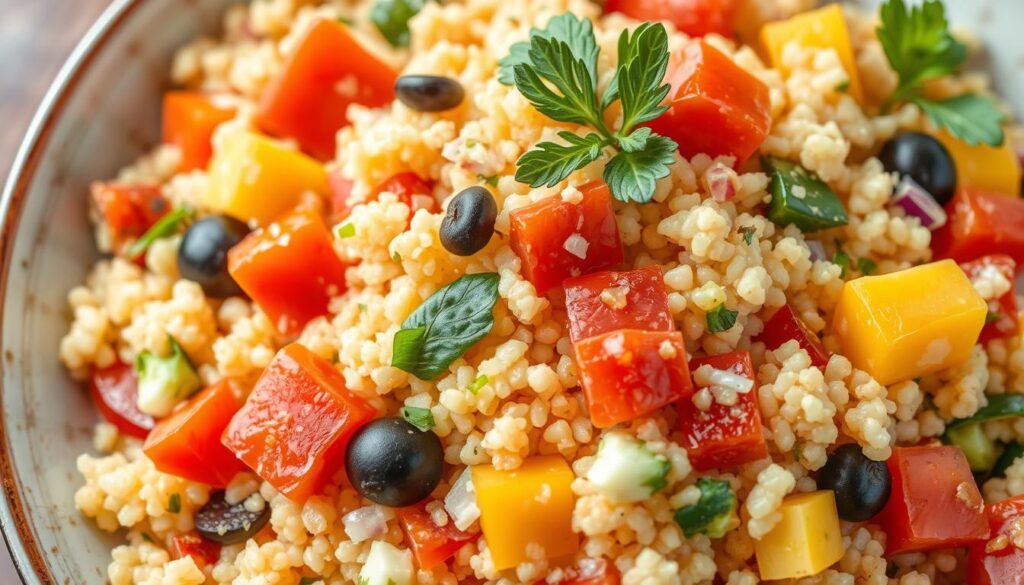
Moroccan Soups for Every Season
In Morocco, soups are more than just a meal; they’re an experience that brings people together. We take pride in our rich tradition of soups, ranging from hearty winter warmers to refreshing summer options.
Harira: The Ramadan Staple
Harira is a traditional Moroccan soup made with tomatoes, lentils, and chickpeas, typically served to break the fast during Ramadan. This nourishing soup is a staple in Moroccan cuisine, offering a boost of energy after a day of fasting. To make harira, you’ll need ingredients like onions, garlic, and a blend of spices including cumin and coriander.
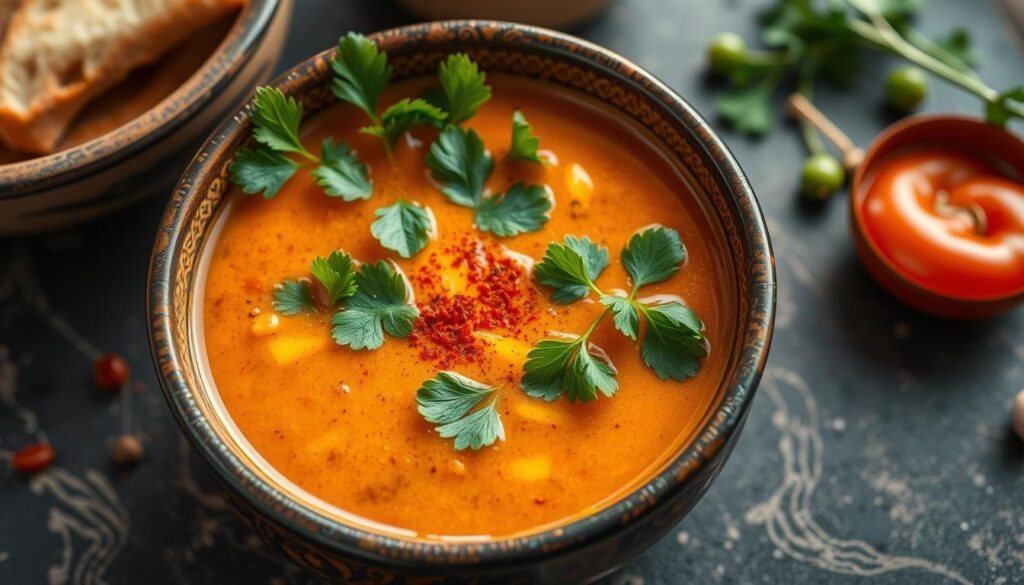
Bisarra: Creamy Fava Bean Soup
Bisarra is a creamy and comforting fava bean soup that’s naturally vegan and gluten-free. This traditional Moroccan dish is made with just a few simple ingredients, including fava beans, garlic, and olive oil, before being pureed to a smooth consistency. Bisarra is not only delicious but also low in fat, making it a healthy option for any meal.
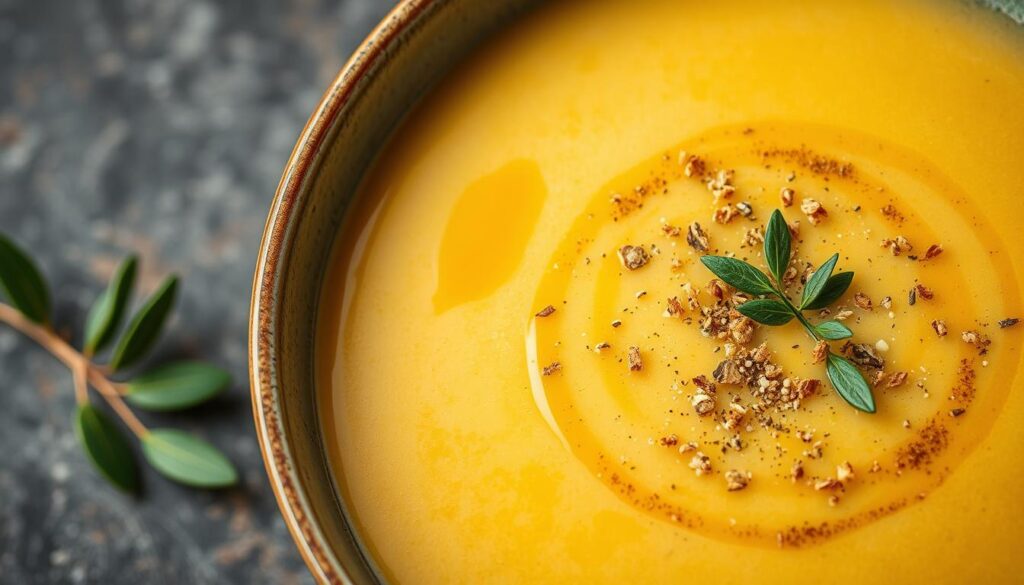
Refreshing Moroccan Salads
The world of Moroccan salads is as diverse as it is flavourful, offering a range of options for every palate. Moroccan salads are often served as starters or side dishes to complement main courses, adding a burst of freshness and flavour to the meal.
Classic Moroccan Tomato Salad
Today we’re making a classic Moroccan tomato salad that’s loaded with juicy tomatoes, fresh herbs, and traditional Moroccan spices. This salad is a staple in Moroccan cuisine, and its simplicity is part of its charm.
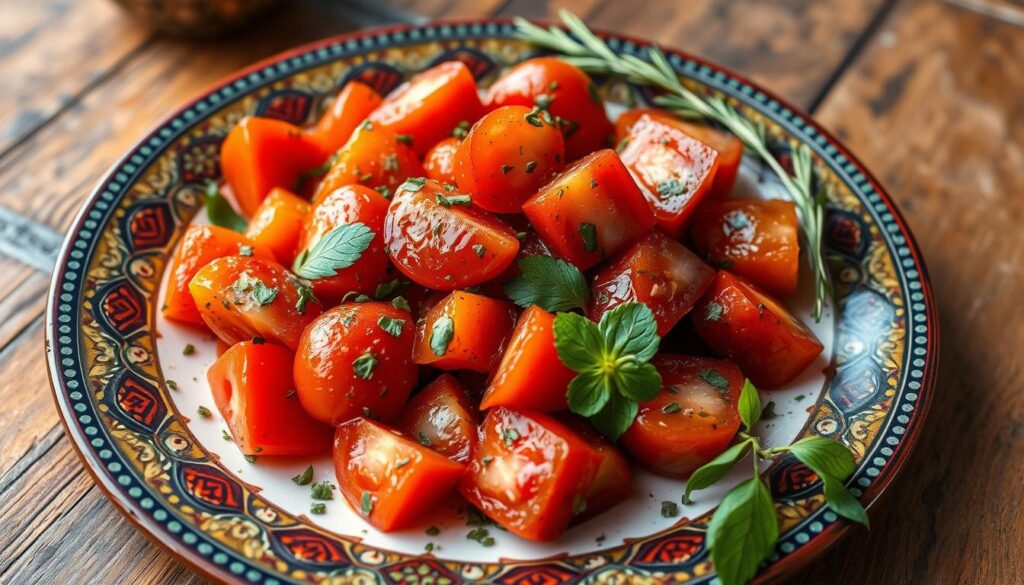
Zaalouk: Eggplant Dip
We’re making one of our favourite vegan dishes, Zaalouk. This Moroccan eggplant dip is made with fresh eggplant, tomato, spices, and olive oil. It’s fabulous served as a salad, in a tagine, or as a dip with bread.
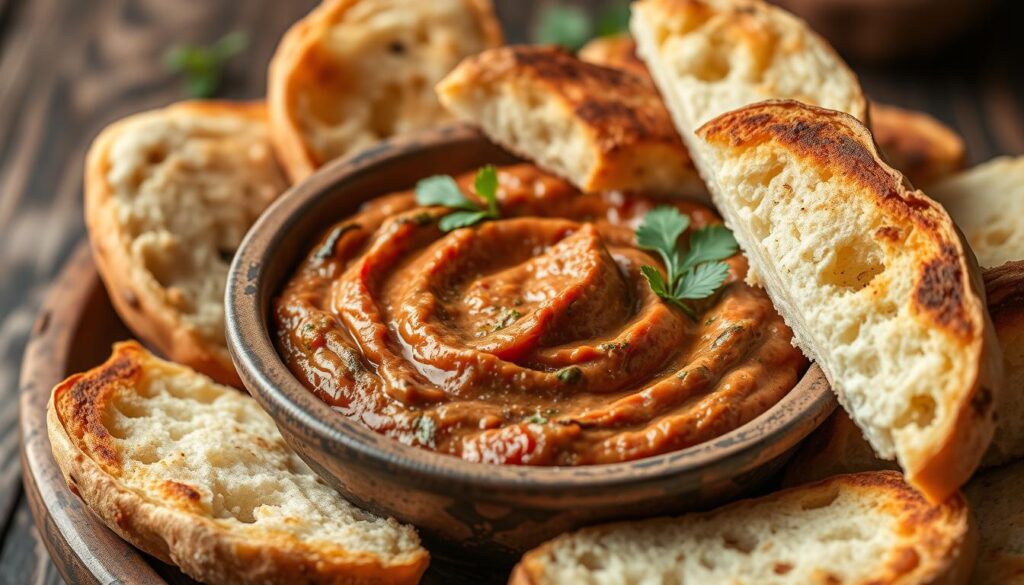
Moroccan Carrot Salad
We’re making a popular Moroccan Carrot Salad that’s vegan, gluten-free, and requires only four ingredients. This salad delivers a perfect balance of sweet and tangy notes, making it a great addition to any meal.
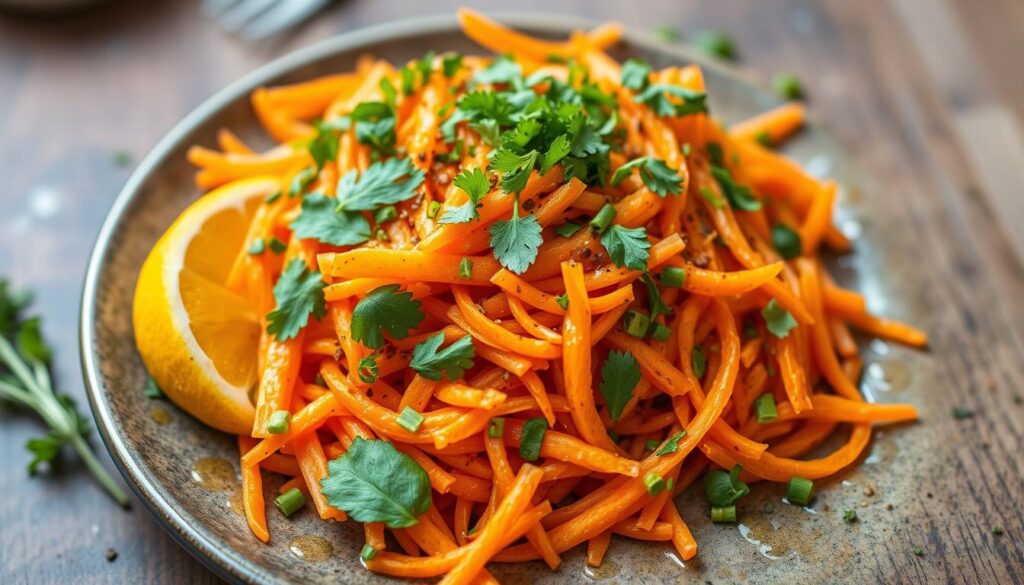
These salads showcase the diversity and richness of Moroccan cuisine, offering a range of flavours and textures to enjoy. Whether you’re looking for a refreshing side dish or a hearty main course, Moroccan salads have something to offer.
Moroccan Street Food Favourites
Moroccan street food favourites are a perfect blend of traditional spices and succulent meats. We take you on a culinary journey through the bustling streets of Marrakech and Fez, recreating the authentic flavours of Morocco at home.
Grilled Lamb Chops with Cumin
Our grilled lamb chops recipe is a staple of Moroccan street food, flavoured with cumin and ready in under 30 minutes. Traditionally served with a cumin-salt mixture, this dish is a simple yet flavourful delight.
Merguez Sausages
Merguez sausages are spicy North African lamb sausages that are a favourite among locals and visitors alike. We share our authentic recipe, allowing you to adjust the spices to suit your taste, making it a truly personalised meat recipe.
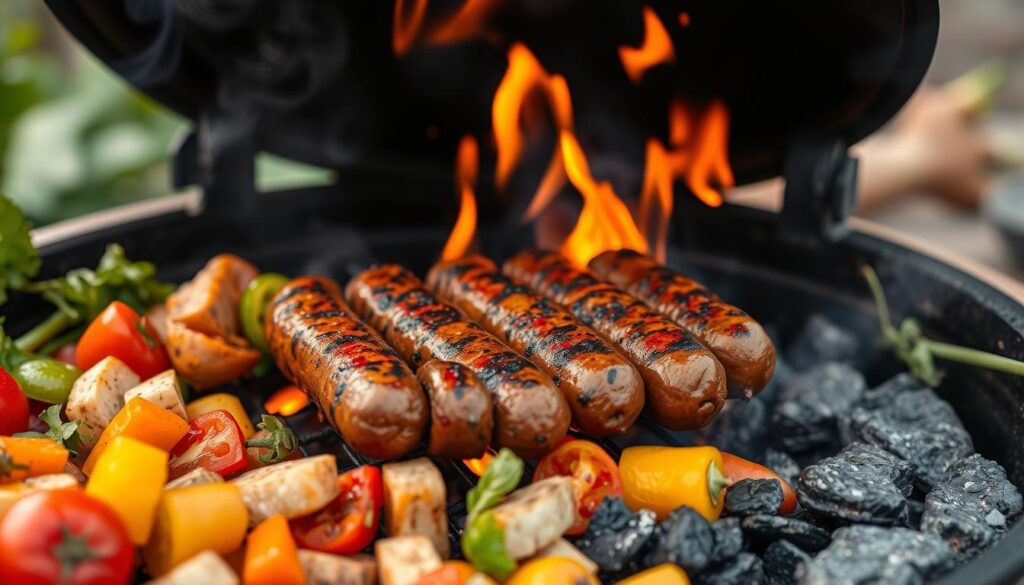
Traditional Moroccan Breakfast Recipes
We invite you to explore the rich world of traditional Moroccan breakfast recipes, which offer a flavourful alternative to typical Western morning meals. Moroccan breakfasts are known for their rich flavours and hearty ingredients, making them a great way to start the day.
Baghrir: Moroccan Semolina Pancakes
Baghrir, also known as thousand-hole pancakes, are a staple in Moroccan breakfast cuisine. Made with semolina flour, these light and spongy pancakes are cooked on a griddle and are characterised by their honeycomb-like surface. To make baghrir, you’ll need semolina flour, yeast, and water. The batter is left to rest before being cooked into perfectly holey pancakes.
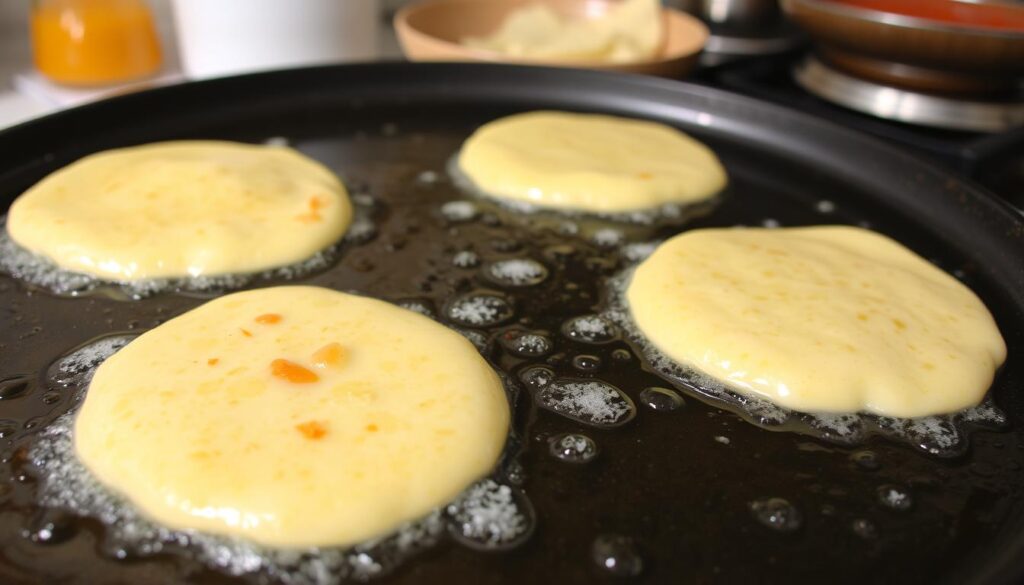
Shakshuka: Moroccan-Style
Shakshuka is a versatile and delicious dish that can be enjoyed at any meal, including breakfast. Our Moroccan-style shakshuka recipe features eggs poached in a richly spiced tomato and red pepper sauce, all coming together in just 30 minutes. This hearty dish is perfect for serving with a crusty loaf of bread.
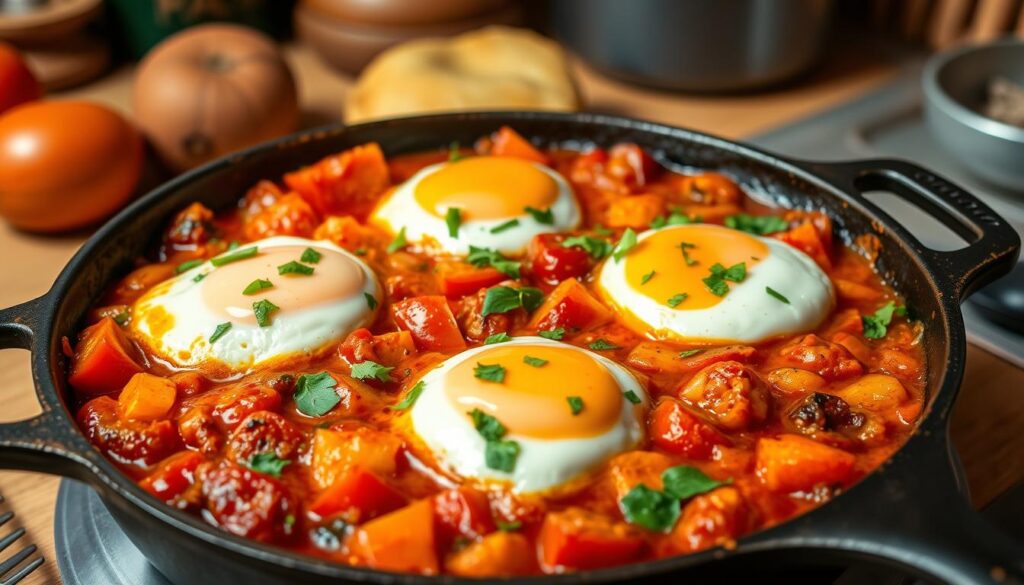
Both baghrir and shakshuka showcase the diversity and richness of Moroccan cuisine, offering a delicious start to the day. Whether you’re looking to try something new for breakfast or simply want to explore the flavours of Morocco, these recipes are sure to impress.
Sweet Treats: Moroccan Desserts
Discover the enchanting world of Moroccan desserts, where every bite tells a story. Moroccan sweets are known for their rich flavours and beautiful presentation, often featuring ingredients like honey, nuts, and aromatic spices.
Halwa Chebakia: Sesame Cookies
Halwa Chebakia are traditional Moroccan sesame cookies fried and then soaked in honey scented with orange blossom water. These flower-shaped treats are loaded with warming spices like turmeric and saffron, making them perfect for sharing during holidays.

Gazelle Horns: Almond Cookies
Gazelle Horns, or Cornes de Gazelle, are elegant crescent-shaped cookies filled with a fragrant almond paste. Made with a thin pastry shell, these cookies are as beautiful as they are delicious, making them a classic Moroccan dessert.

Refreshing Moroccan Beverages
In Morocco, beverages are an integral part of the culture, serving not just to quench thirst but to foster hospitality and social bonding. We invite you to explore the traditional drinks that are central to Moroccan hospitality.
Traditional Moroccan Mint Tea
Moroccan mint tea, or “Atay,” is a staple of Moroccan hospitality, made with fresh mint leaves, gunpowder green tea, and sugar. To prepare it, add gunpowder tea pellets to a teapot, then pour in hot water and let it steep. The tea is then poured from a height to create a frothy top.
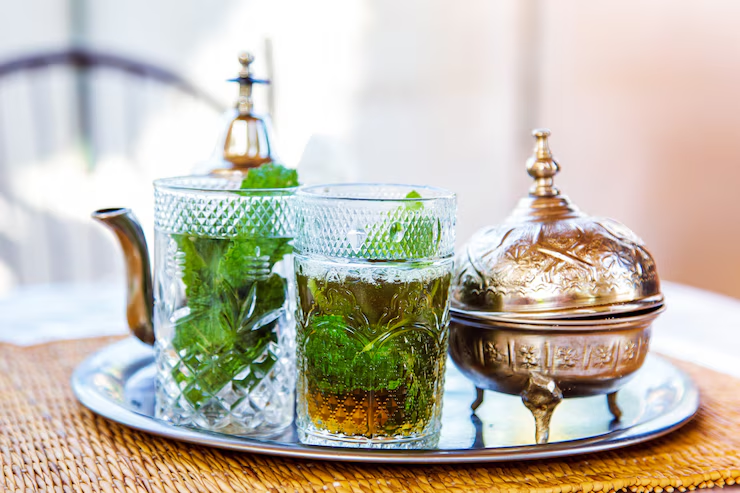
Moroccan Spiced Coffee
For a warm and aromatic coffee experience, try Moroccan spiced coffee, infused with spices like cardamom, cinnamon, and nutmeg. Simply add these spices to your coffee grounds before brewing with heat and water, then sweeten with sugar to taste. This exotic twist on traditional coffee is sure to delight.
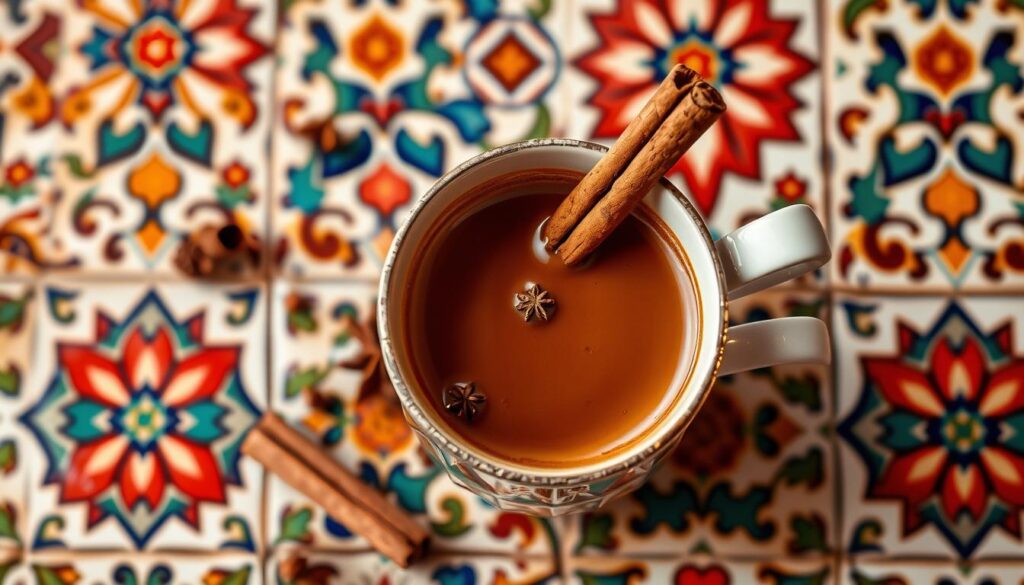
Essential Moroccan Condiments and Staples
The foundation of authentic Moroccan cooking lies in its condiments and staples, which we will explore in this section. These ingredients are crucial for adding depth and authenticity to various Moroccan dishes.
Preserved Lemons
Preserved lemons are a staple in Moroccan cuisine, adding a distinctive tangy flavour to tagines, sauces, and marinades. To make preserved lemons, you’ll need fresh lemons, salt, and water. Simply slice the lemons, pack them in a jar with salt, and let them cure.
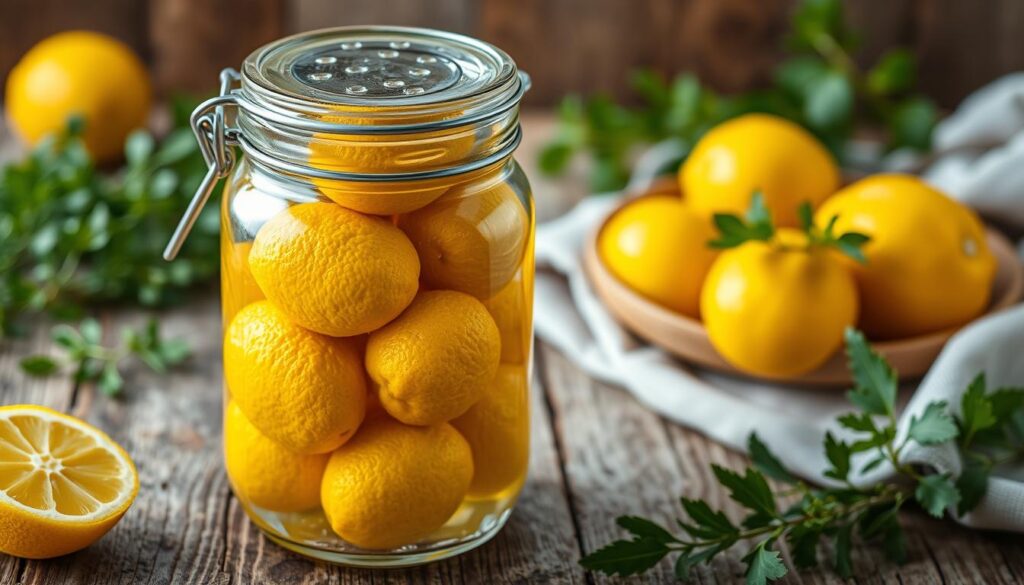
Harissa Paste
Harissa paste is a North African hot sauce made with dried chillies, preserved lemon, and traditional spices. It adds a spicy kick to various Moroccan dishes. To make harissa paste, blend together dried chillies, garlic, coriander, and olive oil.
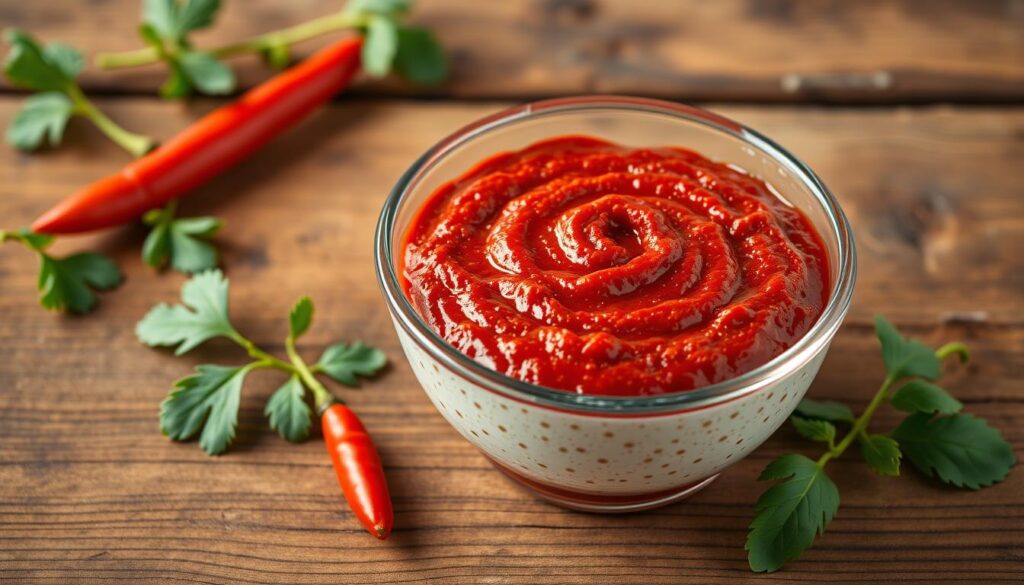
Ras El Hanout Spice Blend
Ras El Hanout, meaning “top shelf,” is a classic Moroccan spice blend that combines up to 30 different spices. It’s a versatile seasoning used in various Moroccan recipes. To make Ras El Hanout, blend together spices like cumin, coriander, cinnamon, and ginger.
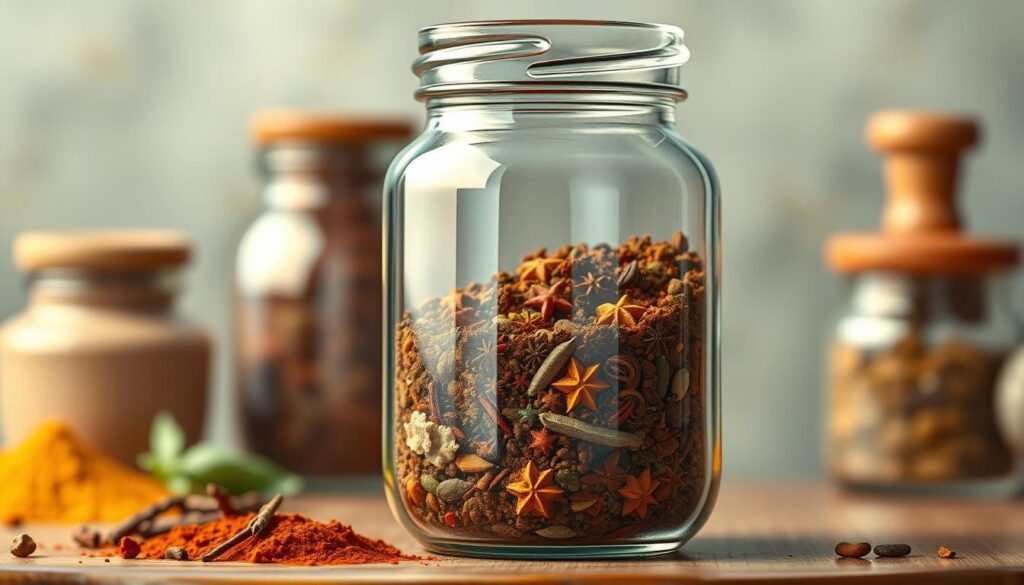
By incorporating these essential condiments and staples into your cooking, you’ll be able to create authentic Moroccan dishes that are full of flavour and depth.
Moroccan Cooking Techniques
From slow-cooked stews to intricately prepared pastries, Moroccan cooking techniques are as diverse as they are fascinating. Moroccan cuisine’s depth of flavour and unique character are largely due to its distinctive cooking methods.
We’ll explore the techniques that give Moroccan dishes their signature taste and texture. One of the hallmarks of Moroccan cooking is its use of slow cooking methods.
Slow Cooking Methods
Slow cooking is a cornerstone of Moroccan cuisine, allowing flavours to develop fully and tougher cuts of meat to become tender and succulent. This method involves cooking ingredients over low heat for an extended period, typically using a tagine pot.
Benefits of Slow Cooking include richly flavoured dishes without excessive fat, as aromatic spice blends and slow-simmered broths serve as flavour foundations. To achieve this, chefs often use a combination of spices, herbs, and sometimes preserved lemons or olives to add depth.
Balancing Sweet and Savoury Flavours
Another key aspect of Moroccan cooking is the balance between sweet and savoury elements. This balance creates complex, multi-layered flavour profiles that are characteristic of Moroccan cuisine. For example, dishes like chicken tagine with apricots or lamb tagine with prunes showcase this balance.
- Using a mix of sweet ingredients like dried fruits and savoury elements such as meat or vegetables.
- Employing aromatic spice blends like Ras El Hanout to add depth without overpowering the dish.
- Cooking methods that allow flavours to meld together, such as slow cooking or braising.
By mastering these techniques, you can create authentic Moroccan dishes that are full of flavour and character, even in a modern kitchen with time constraints.
Hosting a Moroccan-Themed Dinner Party
Bringing the essence of Morocco to your dinner table is easier than you think with our hosting tips. We specialise in guiding you through the process of creating an authentic Moroccan dining experience.
To start, let’s explore the key elements that will make your dinner party unforgettable. A well-planned menu is crucial, and we’ll show you how to balance traditional Moroccan courses with effective preparation time management.
Menu Planning Tips
Planning a Moroccan menu involves selecting dishes that complement each other and cater to your guests’ dietary needs. Start with traditional appetisers like salads, followed by a main course featuring a slow-cooked tagine, and finish with sweet pastries for dessert.
| Course | Traditional Moroccan Dish | Preparation Time |
|---|---|---|
| Appetiser | Moroccan Salads (e.g., Zaalouk, Carrot Salad) | 30 minutes |
| Main Course | Chicken or Lamb Tagine | 1-2 hours |
| Dessert | Halwa Chebakia or Gazelle Horns | 45 minutes |
Traditional Serving Customs
Moroccan cuisine is not just about the food; it’s also about the experience. Traditional serving customs include presenting salads as starters and serving main dishes from communal platters, fostering a sense of community among your guests.
To enhance the authenticity of your dinner party, consider using traditional Moroccan serving vessels and decorative elements. This will not only add to the ambiance but also create a memorable experience for your guests.
Health Benefits of Moroccan Cuisine
Moroccan cuisine is not just about delicious flavours; it’s also packed with numerous health benefits. We’ll explore the numerous health benefits associated with traditional Moroccan cuisine, which emphasises fresh ingredients, aromatic spices, and balanced nutrition.
Nutritional Value of Common Ingredients
You’ll learn about the nutritional value of common Moroccan ingredients like olive oil, garlic, fresh herbs, and spices that offer antioxidant and anti-inflammatory properties. The use of olive oil, rich in healthy fats, is a staple in Moroccan cooking, contributing to the cuisine’s health benefits. Garlic, another fundamental ingredient, is known for its immune-boosting properties.
Mediterranean Diet Connections
We’ll highlight how many Moroccan dishes naturally align with the principles of the Mediterranean diet, which is widely recognised for its health benefits. The emphasis on whole grains, vegetables, and healthy fats in Moroccan cuisine mirrors the Mediterranean diet’s focus on nutrient-rich foods.
Discover how traditional Moroccan cooking methods often preserve nutrients while using relatively little added fat. Incorporating Moroccan recipes into your regular meal rotation can contribute to a varied, nutrient-rich diet that supports overall health and wellbeing.
- Moroccan cuisine emphasises fresh ingredients and aromatic spices.
- Common ingredients like olive oil and garlic offer significant health benefits.
- Moroccan dishes align with the principles of the Mediterranean diet.
Conclusion
As we conclude our culinary journey through Morocco, we invite you to bring the flavours of this vibrant country into your home. We’ve explored the rich tapestry of Moroccan cuisine recipes that bring exotic flavours to your kitchen.
Through our journey, you’ve discovered how key ingredients like preserved lemons, olives, and aromatic spices create the distinctive character of Moroccan dishes, such as chicken tagine. We’ve shared traditional recipes for classics like couscous and sweet pastries.
We hope this guide inspires you to experiment with Moroccan flavours and techniques, adding a touch of North African magic to your cooking repertoire, balancing sweet and savoury elements with ingredients like honey, garlic, and onion.

